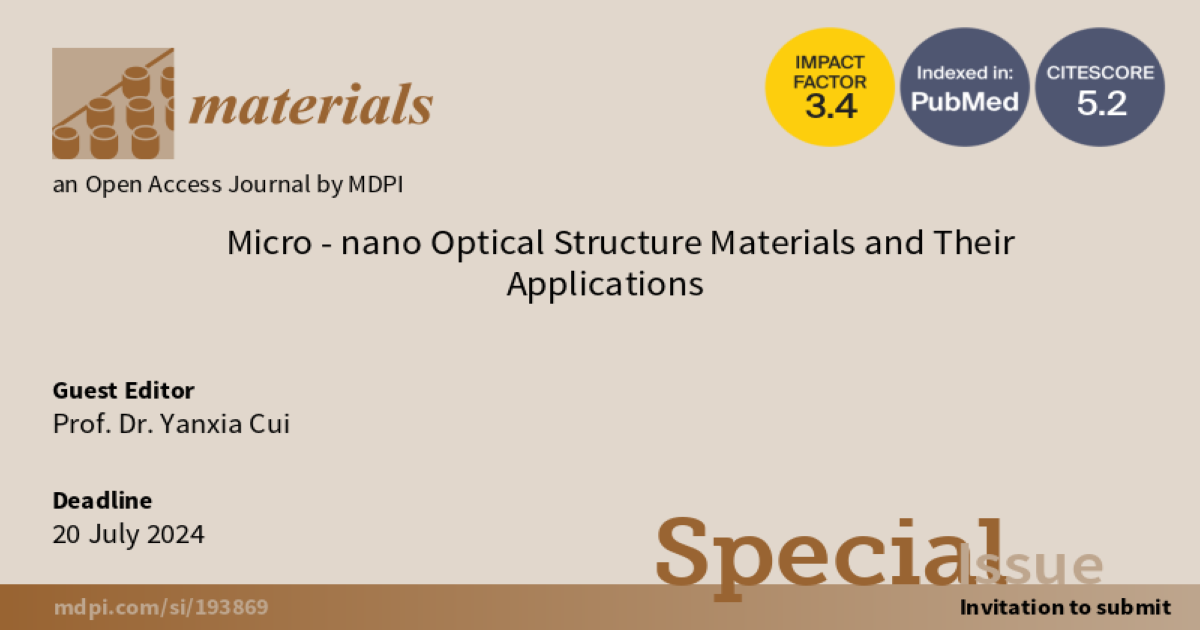- 3.2Impact Factor
- 6.4CiteScore
- 16 daysTime to First Decision
Micro-nano Optical Structure Materials and Their Applications
This special issue belongs to the section “Optical and Photonic Materials“.
Special Issue Information
Dear Colleagues,
Micro-nano optical structures—which rely on local resonance, electromagnetic field enhancement, the slow-light effect, and so on—could effectively manipulate the interaction characteristics between light and matter (such as atoms, molecules, quantum dots, and nonlinear materials). This concept finds extensive applications in photon integration, sensitive signal detection and recognition, biochemical sensing, super-resolution microscopic imaging, efficient solar cell and light-emitting device development, advancements in disease diagnosis and treatment, environmental monitoring practices, and many other crucial domains.
As an underlying component in solar cells or other optoelectronic devices, micro-nano structural materials give these devices unique optical, electrical, and mechanical properties, and provide a way to develop new and functional flexible photonic and electronic devices. This way of optimizing the structure of photoelectric devices can result in a change in the refractive index gradient at their window layer, which can effectively inhibit reflection and generate surface plasmon resonance near the metal structure. Ultimately, this can enhance light absorption and, importantly, lead to improvements to the overall performance of the photoelectric device.
By constructing isoplasmon heterogeneous nanostructures, plasmon materials with a highly efficient light capture ability (and their interaction with neighbouring materials), could enhance the energy conversion efficiency of photon-electrons and photon–chemical interactions in photovoltaic and photocatalysis processes and optical processes in a variety of linear (fluorescence) and nonlinear (second harmonic, multi-photon emission) manners. The introduction of micro-nano structures into metal halide perovskites can further improve their photoelectric performance and chemical and environmental stability. Further, micro-nano structures can enhance the optical absorption band gap effect through their anti-reflection properties, scattering enhancement, resonance mode, and PC light-trapping strategies.
Prof. Dr. Yanxia Cui
Guest Editor
Manuscript Submission Information
Manuscripts should be submitted online at www.mdpi.com by registering and logging in to this website. Once you are registered, click here to go to the submission form. Manuscripts can be submitted until the deadline. All submissions that pass pre-check are peer-reviewed. Accepted papers will be published continuously in the journal (as soon as accepted) and will be listed together on the special issue website. Research articles, review articles as well as short communications are invited. For planned papers, a title and short abstract (about 250 words) can be sent to the Editorial Office for assessment.
Submitted manuscripts should not have been published previously, nor be under consideration for publication elsewhere (except conference proceedings papers). All manuscripts are thoroughly refereed through a single-blind peer-review process. A guide for authors and other relevant information for submission of manuscripts is available on the Instructions for Authors page. Materials is an international peer-reviewed open access semimonthly journal published by MDPI.
Please visit the Instructions for Authors page before submitting a manuscript. The Article Processing Charge (APC) for publication in this open access journal is 2600 CHF (Swiss Francs). Submitted papers should be well formatted and use good English. Authors may use MDPI's English editing service prior to publication or during author revisions.
Keywords
- surface plasmon
- photodetector
- perovskite
- micro- and nano-scale optical structures
- imaging device

Benefits of Publishing in a Special Issue
- Ease of navigation: Grouping papers by topic helps scholars navigate broad scope journals more efficiently.
- Greater discoverability: Special Issues support the reach and impact of scientific research. Articles in Special Issues are more discoverable and cited more frequently.
- Expansion of research network: Special Issues facilitate connections among authors, fostering scientific collaborations.
- External promotion: Articles in Special Issues are often promoted through the journal's social media, increasing their visibility.
- e-Book format: Special Issues with more than 10 articles can be published as dedicated e-books, ensuring wide and rapid dissemination.

